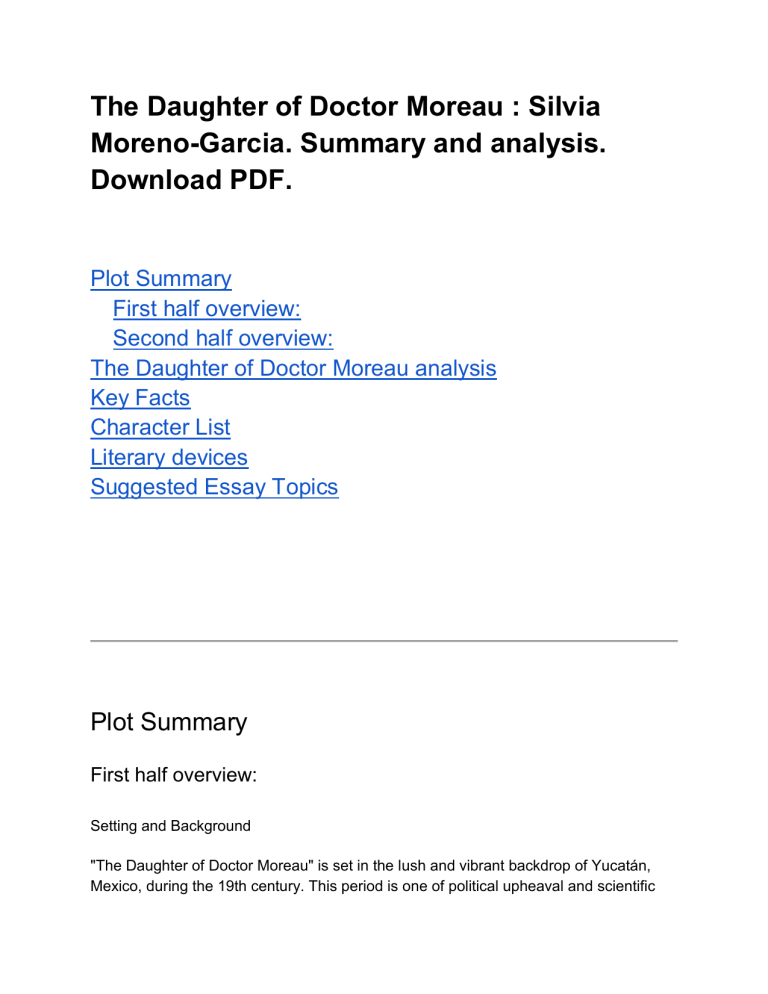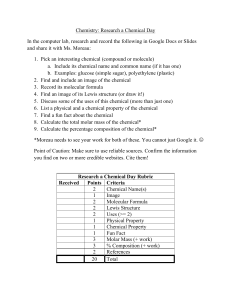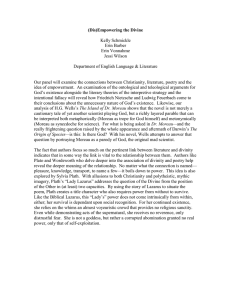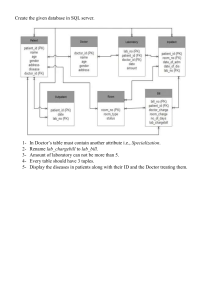The Daughter of Doctor Moreau by Silvia Moreno-Garcia. Summary and analysis. Download PDF.
advertisement

The Daughter of Doctor Moreau : Silvia Moreno-Garcia. Summary and analysis. Download PDF. Plot Summary First half overview: Second half overview: The Daughter of Doctor Moreau analysis Key Facts Character List Literary devices Suggested Essay Topics Plot Summary First half overview: Setting and Background "The Daughter of Doctor Moreau" is set in the lush and vibrant backdrop of Yucatán, Mexico, during the 19th century. This period is one of political upheaval and scientific discovery, providing a rich tapestry against which the story unfolds. The novel pays homage to H.G. Wells' classic, "The Island of Doctor Moreau," reimagining it within this new cultural and historical context. Main Characters - Carlota Moreau: The titular character, Carlota is the daughter of the enigmatic and brilliant Doctor Moreau. She has grown up isolated on her father's estate, sheltered from the outside world and the truth of her father's experiments. - Doctor Moreau: A scientific genius with a god complex, Doctor Moreau conducts experiments on animals, attempting to elevate them to human status through a series of cruel and painful procedures. - Montgomery Laughton: An outsider with a murky past, Montgomery finds himself employed by Doctor Moreau. He serves as a protector of sorts to Carlota, and his perspective introduces the readers to the mysteries and horrors of the Moreau estate. - The Hybrids: A result of Doctor Moreau's experiments, these animal-human hybrids serve the estate in various capacities. They are a testament to Moreau's genius and cruelty, each bearing physical and emotional scars from their transformations. Themes Science and Morality: The novel delves into the ethical implications of scientific experimentation, particularly the manipulation of living beings. Doctor Moreau's god complex and his justification of his work raise questions about the boundaries of scientific pursuit. Identity and Otherness: Through Carlota and the hybrids, the story explores themes of identity, belonging, and the concept of the "other." Carlota's journey of self-discovery and her interactions with the hybrids challenge societal notions of purity and monstrosity. Colonialism and Exploitation: The setting and character dynamics reflect the broader themes of colonialism and the exploitation of the land and its people. The Moreau estate itself can be seen as a microcosm of these historical and social dynamics. Summary of the First Half The story begins with an introduction to the secluded and mysterious world of the Moreau estate, where Doctor Moreau's ambitious and morally ambiguous experiments set the stage. Carlota, who has been shielded from the darkest truths of her father's work, begins to question the nature of her existence and the ethics of her father's experiments as she grows older. Montgomery Laughton, who arrives at the estate with his own set of secrets and guilt, becomes a catalyst for change. His perspective on Moreau's work and his growing concern for Carlota and the hybrids introduce a conflict between the desire to protect and the need to expose the truth. As tensions mount, the first half of the book focuses on Carlota's gradual awakening to the realities of her world. Her interactions with the hybrids, who are at once kindred spirits and reminders of her father's cruelty, force her to confront her own complicity and ignorance. Meanwhile, the political turmoil outside the estate's walls threatens to invade the insulated world of Doctor Moreau, bringing with it challenges and revelations that Carlota and Montgomery must face together. The first half of "The Daughter of Doctor Moreau" sets up a compelling narrative of discovery, conflict, and the search for identity against a backdrop of ethical dilemmas and societal commentary. It promises a journey that is as much about the darkness within as it is about the illuminated path toward understanding and redemption. Conclusion While this summary provides an overview of the themes, characters, and initial conflicts introduced in the first half of "The Daughter of Doctor Moreau," the novel is rich with detail, emotion, and moral complexity that defies simple summarization. Silvia MorenoGarcia crafts a story that is both a tribute to and a reimagining of Wells' classic, inviting readers to explore the depths of human and animal nature, the dangers of unchecked ambition, and the possibility of compassion and change. Second half overview: As we delve into the latter half of Silvia Moreno-Garcia's evocative novel, "The Daughter of Doctor Moreau," the narrative tension escalates, unearthing deep-seated themes of identity, freedom, and the blurred lines between humanity and the monstrous. Through Moreno-Garcia's lush prose and vivid characterization, we are drawn deeper into the heart of Yucatán, where the ethics of creation and the cost of ambition are examined through the intertwined fates of Carlota Moreau, her father, Doctor Moreau, and the enigmatic Montgomery Laughton. Navigating Complex Relationships Carlota, whose life until now has been sheltered and filled with a naive sense of normalcy despite her unique family and surroundings, begins to question her father's work and her own place within this secluded world. The complex dynamic between Carlota and her father deepens, marked by her growing awareness of his morally ambiguous experiments and her own complicity in the secluded estate's secrets. Montgomery Laughton, whose past and motivations have been shrouded in mystery, emerges as a more complex figure. His relationship with both the Moreaus and the hybrid creatures serves as a catalyst for change, challenging Carlota to see beyond the boundaries of her isolated existence. The Hybrids' Rebellion The narrative takes a pivotal turn as the hybrids, long subjected to Doctor Moreau's will, begin to voice their discontent and yearn for autonomy. Moreno-Garcia masterfully explores themes of oppression and the quest for identity through these characters, who despite their non-human attributes, exhibit deeply human desires and fears. This brewing unrest among the hybrids serves as a mirror to Carlota's own awakening, as she grapples with questions of morality, loyalty, and her future. Unraveling Secrets The lush backdrop of Yucatán becomes a character in its own right, with the jungle's oppressive heat and hidden dangers reflecting the simmering tensions on the estate. As Carlota ventures beyond her father's domain, she unearths secrets that challenge everything she has known. The arrival of outsiders, including an ambitious businessman and a mysterious figure from Montgomery's past, introduces new threats to the fragile equilibrium of Doctor Moreau's world. Confronting the Past Doctor Moreau, a figure of god-like ambition and flawed humanity, is confronted with the consequences of his actions. His past, filled with hubris and tragic mistakes, is revealed, offering insights into his motivations but also exposing the depth of his obsession. Carlota must reconcile her love for her father with the horror of his experiments, leading to poignant moments of realization and confrontation. A Path Forward The latter chapters of the novel are charged with tension as alliances shift and the estate's insular community braces for an inevitable clash. Carlota, emerging as a determined and compassionate protagonist, seeks to forge a new path that honors her complex heritage while striving for a more just future for both the hybrids and the humans in her life. The culmination of these events is a testament to Moreno-Garcia's skill in weaving a narrative that is at once fantastical and deeply human. The resolution, without delving into specifics, offers a blend of hope and melancholy, leaving readers to ponder the nature of freedom, the price of progress, and the enduring search for one's place in the world. Reflections "The Daughter of Doctor Moreau" is not just a tale of scientific hubris or a retelling of a classic story; it is a deeply felt exploration of identity, family, and the possibility of redemption. Moreno-Garcia's characters, human and hybrid alike, linger in the mind, their struggles and dreams echoing long after the final page is turned. As we close the book on this engrossing narrative, we are reminded of the enduring power of storytelling to challenge, to illuminate, and to empathize. Silvia Moreno-Garcia has crafted a novel that is both a paean to the wonders of the natural world and a cautionary tale of the perils that await when man seeks to dominate it. --This overview aims to capture the essence and trajectory of the latter half of "The Daughter of Doctor Moreau" without revealing specific plot points or outcomes. It is a reflection on the themes, character development, and overarching questions raised by Moreno-Garcia's compelling narrative, providing a tantalizing glimpse into the world she has created. The Daughter of Doctor Moreau analysis Silvia Moreno-Garcia's novel, "The Daughter of Doctor Moreau," is a lush, ambitious retelling that extends the thematic and narrative boundaries of H.G. Wells' classic, "The Island of Doctor Moreau." It relocates the tale's core to the dense, vibrant jungles of Yucatán in the late 19th century, infusing it with colonial and postcolonial sensibilities, gender dynamics, and a profound exploration of identity and autonomy. This analysis will delve into the multifaceted layers of Moreno-Garcia's work, touching on its themes, character development, setting, and its broader cultural and ethical implications. Themes and Motifs At the heart of Moreno-Garcia's novel are the intertwined themes of creation and destruction, freedom and captivity, and the blurred lines between humanity and monstrosity. The story probes deeply into the ethics of scientific experimentation and the consequences of playing god, echoing the concerns of Wells' original work while providing a fresh and nuanced perspective that resonates with contemporary discussions about biotechnology and genetic engineering. The theme of identity is central to the narrative, explored not just through the titular character, Carlota Moreau, but also through the hybrid creatures that inhabit her father's estate. These beings, part human and part animal, challenge the characters and readers alike to reconsider what it means to be human, to have agency, and to desire freedom. Moreno-Garcia deftly uses their plight to critique colonialism and its dehumanizing effects, drawing parallels between the hybrids' struggle for autonomy and the historical subjugation of indigenous peoples. Character Development Carlota Moreau, as the protagonist, undergoes a significant transformation throughout the novel. Initially sheltered and naive, her journey is one of awakening and selfdiscovery, driven by her increasingly complex understanding of her father's work and her own complicity in the estate's secrets. Her evolving relationships with the hybrid beings and the enigmatic Montgomery Laughton serve as catalysts for her growth, challenging her worldview and forcing her to confront difficult moral quandaries. Doctor Moreau is portrayed as a figure of immense ambition and moral ambiguity. Through his character, Moreno-Garcia explores the dangers of unchecked scientific pursuit and the hubris of believing in one's ability to control nature. The complexity of his character raises questions about the nature of evil and the capacity for redemption. Montgomery Laughton, with his mysterious past and moral complexity, adds another layer to the narrative, embodying themes of guilt, redemption, and the search for belonging. His interactions with Carlota and the hybrids enrich the story, offering insights into the characters' inner lives and the possibilities for change. Setting as Character The lush landscape of Yucatán is more than just a backdrop; it is a living, breathing entity that shapes the story's mood and themes. Moreno-Garcia's vivid descriptions immerse readers in the setting, highlighting the beauty and danger of the natural world. The jungle becomes a metaphor for the untamed, unpredictable aspects of both the scientific endeavors at the heart of the story and the characters' internal struggles. Cultural and Ethical Implications "The Daughter of Doctor Moreau" engages with a range of cultural and ethical issues, from the legacy of colonialism to the ethical boundaries of scientific inquiry. MorenoGarcia's reimagining of Wells' story through a postcolonial lens invites readers to reflect on the continuing impacts of colonialism and the ways in which science and technology can be implicated in systems of oppression. The novel also raises questions about the relationship between creator and creation, exploring the responsibilities and ethical considerations that come with the power to alter life. In doing so, it engages with ongoing debates about genetic engineering, animal rights, and the definition of personhood, making the story both timely and timeless. Conclusion "The Daughter of Doctor Moreau" is a richly layered novel that transcends its source material to offer a poignant, thought-provoking exploration of identity, freedom, and the ethics of creation. Silvia Moreno-Garcia's masterful storytelling, combined with her deep understanding of the thematic and historical contexts of the narrative, makes this work a compelling read that resonates with contemporary concerns while paying homage to a classic of science fiction. Through its complex characters, vivid setting, and engaging plot, the novel invites readers to reflect on the nature of humanity, the consequences of our actions, and the possibility of a more just and compassionate world. Key Facts Genre Science Fiction, Historical Fiction, Gothic Publication Date 2022 Publisher Del Rey Books (an imprint of Penguin Random House) Setting Yucatán Peninsula, Mexico; Late 19th Century Main Characters Carlota Moreau: The daughter of Doctor Moreau, who has been raised in isolation on her father’s estate. Doctor Moreau: A scientist conducting experiments to create hybrid creatures. Montgomery Laughton: An enigmatic figure who arrives at the estate and becomes entwined with Carlota and her father’s secrets. The Hybrids: A group of animal-human creatures created by Doctor Moreau. Themes thics of scientific experimentation Identity and autonomy Colonialism and postcolonialism <br> Nature vs. nurture Freedom and captivity Inspiration Inspired by H.G. Wells' "The Island of Doctor Moreau" (1896), Moreno-Garcia’s novel reimagines the story with a new setting and thematic focuses. Awards/Nominations Information on specific awards or nominations might be subject to updates beyond the knowledge cutoff date. Character List Carlota Moreau - Full Name: Carlota Moreau - Analysis: Carlota is the central figure of the novel, the daughter of the enigmatic Doctor Moreau. Raised in isolation on her father's estate in the Yucatán Peninsula, she grows up sheltered from the outside world and unaware of the true nature of her father's experiments. Carlota is depicted as curious, intelligent, and compassionate, struggling with her identity and the moral implications of her father's work as she comes of age. Her journey is one of selfdiscovery, resilience, and the search for autonomy. Doctor Moreau - Full Name: Doctor Moreau (First name not specified) - Analysis: Doctor Moreau is a brilliant but ethically dubious scientist obsessed with his experiments on creating human-animal hybrids. He is a complex character, embodying the archetype of the mad scientist whose ambition blurs the lines between genius and madness. His relationship with Carlota is fraught with secrets and lies, and his actions raise profound ethical questions about the nature of humanity, science, and the exercise of power. Montgomery Laughton - Full Name: Montgomery Laughton - Analysis: Montgomery serves as the catalyst for much of the novel's action. Arriving at the Moreau estate under mysterious circumstances, he is a man with a troubled past and secrets of his own. His relationship with Carlota evolves from one of mutual distrust to a deeper connection, as they both confront the dark realities of Doctor Moreau's work. Montgomery's character explores themes of redemption, loyalty, and the possibility of change. The Hybrids - Analysis: The hybrids are the creations of Doctor Moreau, each with unique animal characteristics fused with human anatomy and cognition. They serve as a poignant exploration of identity, belonging, and otherness. Through their interactions with Carlota and the other human characters, the novel delves into issues of exploitation, the desire for freedom, and the question of what it means to be human. While not all hybrids are named or fully explored, they are crucial to the novel's thematic depth and emotional resonance. Eduardo Lizalde - Full Name: Eduardo Lizalde - Analysis: Eduardo Lizalde is a wealthy patron of Doctor Moreau's work, whose interests are primarily self-serving. His character represents the colonial and exploitative forces at play in the novel, embodying the darker aspects of human nature and the corruption of power. Lizalde's influence over the Moreau estate introduces external threats that escalate the narrative tension, forcing characters to confront their moral boundaries. Supporting Characters - The novel also features a cast of supporting characters, including servants, workers, and visitors to the Moreau estate, each contributing to the novel's rich tapestry of perspectives. These characters add depth to the setting and provide insights into the social and historical context of late 19th century Mexico, further enriching the novel's exploration of its central themes. Silvia Moreno-Garcia's "The Daughter of Doctor Moreau" is a character-driven narrative that uses its cast to explore complex themes of identity, ethics, and humanity. Each character, from the enigmatic Doctor Moreau to his hybrids, plays a pivotal role in unraveling the novel's moral dilemmas and driving its plot forward. Literary devices "The Daughter of Doctor Moreau" by Silvia Moreno-Garcia is rich in literary devices, which contribute to its depth, thematic complexity, and immersive storytelling. Here are some key literary devices used in the book and how they are employed: 1. Allusion - How It's Used: The title itself is an allusion to H.G. Wells' "The Island of Doctor Moreau," setting up expectations for themes of ethical science, creation, and the nature of humanity. Moreno-Garcia uses this allusion to explore similar themes but also diverges to create her own unique narrative and thematic exploration. 2. Imagery - How It's Used: Vivid imagery is used throughout the novel to create a lush, atmospheric setting in the Yucatán Peninsula. Descriptions of the landscape, the opulent yet decaying estate, and the hybrids themselves immerse readers in a world that is both beautiful and unsettling. This imagery reinforces the novel's themes of nature versus nurture and the blurred lines between human and animal. 3. Symbolism - How It's Used: The hybrids serve as a powerful symbol of the consequences of unchecked ambition and the ethical boundaries of scientific exploration. They also represent themes of otherness, identity, and the quest for belonging and acceptance. The jungle surrounding the estate symbolizes both the untamable force of nature and the wildness within each character. 4. Foreshadowing - How It's Used: Moreno-Garcia uses foreshadowing to build suspense and hint at future revelations. Early mentions of secrets, tensions between characters, and mysterious pasts set the stage for later developments in the plot. This technique keeps readers engaged, wondering how these hints will unfold and impact the characters and their relationships. 5. Metaphor - How It's Used: The entire premise of the novel can be seen as a metaphor for the dangers of playing god and the ethical implications of scientific advancements. Doctor Moreau's experiments symbolize humanity's desire to control and manipulate nature, while the consequences of his actions reflect the potential fallout from such hubris. 6. Personification - How It's Used: The jungle and the estate are often personified, imbuing them with a sense of foreboding and agency. This personification emphasizes the novel's Gothic elements, creating a sense of the environment as a living, breathing entity that interacts with the characters and influences the story. 7. Irony - How It's Used: There is a pervasive irony in how the hybrids, created to be subservient and seen as less than human, often display more humanity and compassion than their human creators and captors. This irony is used to critique societal norms, prejudices, and the true nature of humanity. 8. Motif - How It's Used: The motif of isolation runs throughout the novel, not only in the physical isolation of the estate but also in the emotional and existential isolation of the characters. This motif enhances the story's exploration of identity, belonging, and the human need for connection. 9. Juxtaposition - How It's Used: Moreno-Garcia juxtaposes the beauty of the natural world with the horror of Doctor Moreau's experiments, the innocence of Carlota with the darker motives of other characters, and the ideals of progress with the ethical costs of scientific advancement. This juxtaposition highlights the complexities and contradictions within the story and its themes. By employing these literary devices, Silvia Moreno-Garcia crafts a narrative that is not only engaging and thought-provoking but also rich in symbolism and thematic depth. "The Daughter of Doctor Moreau" uses these techniques to explore questions of ethics, identity, and the very essence of what it means to be human. Suggested Essay Topics 1. How does "The Daughter of Doctor Moreau" explore the theme of identity through its characters, especially considering the hybrids? - The novel delves into the complexities of identity through characters like Carlota and the hybrid beings created by her father, Doctor Moreau. The hybrids, being part human and part animal, face a crisis of identity, caught between two worlds and belonging fully to neither. This exploration is crucial for understanding how identity is constructed and perceived both by oneself and society. The narrative invites readers to reflect on the nature of identity and the factors that shape it, such as biology, environment, and personal experience. 2. In what ways does Silvia Moreno-Garcia use the setting to enhance the themes of isolation and otherness in the book? - The lush yet secluded setting of the Yucatán Peninsula serves as a backdrop that amplifies the themes of isolation and otherness. The physical isolation of Doctor Moreau’s estate mirrors the emotional and existential isolation of its inhabitants, particularly the hybrids who are ostracized from human society. The jungle, with its beauty and dangers, symbolizes the wild and untamed aspects of the characters' natures and the story itself. This setting reinforces the feeling of being cut off from the world, highlighting the characters' struggles with their own identities and the societal boundaries that define them. 3. Discuss the ethical implications of scientific advancement as presented in "The Daughter of Doctor Moreau." - The narrative raises critical questions about the ethics of scientific experimentation and the responsibility of creators towards their creations. Doctor Moreau's genetic experiments, aimed at blurring the lines between humans and animals, serve as a focal point for discussions on the moral boundaries of science. Through these experiments, the novel critiques the hubris of playing god and the potential consequences of pursuing knowledge and progress at the expense of ethical considerations. The story prompts readers to consider where the line should be drawn in scientific endeavors and the potential fallout when that line is crossed. 4. Examine the role of colonialism and its effects on the characters and setting in "The Daughter of Doctor Moreau." - The novel is set against the backdrop of colonial Mexico, and its narrative is deeply intertwined with themes of colonialism and its lasting impacts. The characters, including the hybrids, are affected by the colonial power dynamics and exploitation inherent in their society. The story critiques the colonial mindset, highlighting how it dehumanizes individuals and justifies the manipulation and control of others deemed "lesser." Through its portrayal of the characters and their interactions, the book prompts a discussion on the lasting effects of colonialism on identity, power, and selfdetermination. 5. Analyze the use of Gothic elements in "The Daughter of Doctor Moreau" and their significance to the overall narrative. - Moreno-Garcia incorporates Gothic elements, such as the isolated setting, the presence of a mad scientist, and themes of forbidden knowledge, to create a sense of foreboding and to heighten the story's emotional intensity. These elements are not merely decorative but serve to underscore the novel's exploration of human nature, ethics, and the blurred lines between beauty and horror, civilization and wildness. The Gothic atmosphere invites readers to delve deeper into the psychological and moral dilemmas faced by the characters, enhancing the thematic depth of the narrative. Each of these questions invites an in-depth exploration of the novel's complex themes and the ways in which Silvia Moreno-Garcia uses characters, setting, and narrative techniques to engage with pressing ethical, social, and existential questions.




